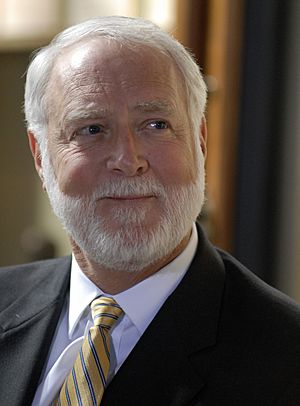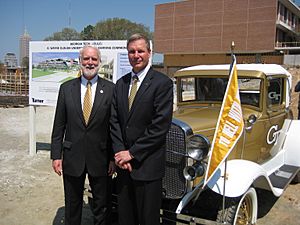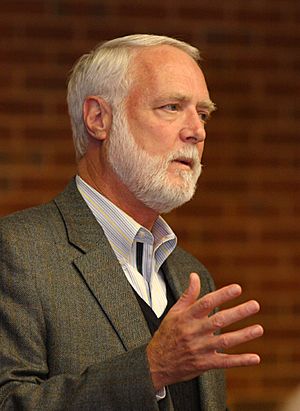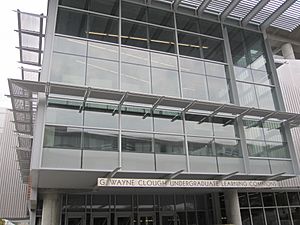G. Wayne Clough facts for kids
Quick facts for kids
Gerald Wayne Clough
|
|
|---|---|

Clough in 2008
|
|
| 12th Secretary of the Smithsonian Institution | |
| In office July 2008 – December 2014 |
|
| Preceded by | Lawrence M. Small |
| Succeeded by | David J. Skorton |
| 10th President of the Georgia Institute of Technology | |
| In office 1994–2008 |
|
| Preceded by | John Crecine |
| Succeeded by | George P. Peterson |
| Personal details | |
| Born | September 24, 1941 Douglas, Georgia, U.S. |
| Nationality | American |
| Spouse | Anne Robinson (deceased) |
| Education | Georgia Institute of Technology (BS, MS) University of California, Berkeley (PhD) |
| Known for | Civil engineering (geotechnical and earthquake engineering) |
| Awards | Norman Medals (1987, 1996) George Westinghouse Award (1986) National Science Board (2004) |
| Scientific career | |
| Fields | Civil engineering |
| Institutions | |
| Thesis | Finite element analyses of soil-structures interaction in U-frame locks (1969) |
| Doctoral advisor | James M. Duncan |
| Other academic advisors | Aleksandar S. Vesic |
| Doctoral students | Jean-Lou Chameau |
Gerald Wayne Clough (born September 24, 1941) is an American engineer and educator. He is known for being the former President of the Georgia Institute of Technology (often called Georgia Tech). He also served as the Secretary of the Smithsonian Institution. Mr. Clough studied civil engineering at Georgia Tech. He was the first former student to become the President of the Institute.
A building at Georgia Tech, the Clough Undergraduate Learning Commons, is named after him. It opened in August 2011. Mr. Clough has received many awards and honors. These include two Norman Medals and eight honorary degrees. He was also a member of the National Science Board.
Contents
Early Life and Education
Gerald Wayne Clough was born on September 24, 1941. He grew up in Douglas, Georgia, and was the youngest of three children. His parents ran a local ice and coal business. Later, his family moved to Chattanooga, Tennessee, where he attended City High School. There, he met Anne Olivia Robinson, who would become his wife. They had two children, Eliza and Matthew.
Mr. Clough started at Georgia Tech in 1959. He earned a bachelor's degree in civil engineering in 1964. While studying, he took part in a cooperative education program. This program allowed him to gain work experience while still in school. He also earned his master's degree in civil engineering from Georgia Tech in 1965. In 1969, he received his Ph.D. (Doctor of Philosophy) in civil engineering. He earned this degree from the University of California, Berkeley. His Ph.D. research focused on how soil and structures interact.
Academic Career and Research
After finishing his doctorate, Mr. Clough began teaching. He became an assistant professor at Duke University in 1969. In 1974, he joined Stanford University as a professor. Later, in 1982, he moved to Virginia Tech. There, he became a professor of civil engineering and led the department for seven years.
In 1990, Mr. Clough became the dean of the Virginia Tech College of Engineering. Even with his leadership roles, he continued his research. His work focused on geotechnical engineering. This field studies the behavior of earth materials. His research included earthquake studies, how soil and structures interact, and underground construction. In 1993, he became a provost at the University of Washington. A provost is a senior academic leader. He also helped start the United States Universities Council of Geotechnical Engineering Research (USUCGER). He was its first president.
Leading Georgia Tech
On September 1, 1994, Mr. Clough made history. He became the first Georgia Tech alumnus to serve as the Institute's President. He was in charge when Atlanta hosted the 1996 Summer Olympics. During his time as president, he made big changes. For example, he separated the Ivan Allen College into two parts. This was a major change that built on earlier reorganizations.
Under his leadership, Georgia Tech grew a lot. The money spent on research more than doubled. All students were required to have computers. The number of students increased from 13,000 to 18,000. Georgia Tech also received an award for supporting student teaching. Its rankings in U.S. News & World Report also improved steadily.
Mr. Clough focused on expanding the campus. Over $1 billion was spent on new buildings and improvements. These projects included new dorms, research centers, and renovated facilities. He also started programs to help undergraduate students get involved in research. He created an International Plan and a fund to help low-income students attend Georgia Tech. Students at Georgia Tech affectionately called him "Funk Masta G. Wayne." He was known for his friendly personality and distinctive beard.
Mr. Clough stepped down as President on July 1, 2008. He had served for almost fourteen years.
Secretary of the Smithsonian Institution
On March 14, 2008, Mr. Clough was chosen as the 12th Secretary of the Smithsonian Institution. The Smithsonian is a group of museums and research centers. He officially started his new role on July 1, 2008. His main goals were to make the Smithsonian's collections available online. He also wanted to offer more educational programs for students from kindergarten to 12th grade.
In November 2008, the Smithsonian opened a board meeting to the public for the first time. Mr. Clough also worked to improve the Smithsonian's buildings and future plans. He also made efforts to reorganize staff and manage the budget.
In 2010, Secretary Clough made a difficult decision. He chose to remove a video artwork called A Fire in My Belly from an exhibition. Some people found the video controversial. Mr. Clough believed it took away from the main message of the exhibition. He said the exhibit was about the contributions of gay and lesbian artists. This decision caused a lot of discussion. However, Mr. Clough stated he was protecting the Smithsonian's larger educational mission. After this, a group was formed to review such decisions in the future. They recommended that art should not be removed from shows once they have opened.
On September 18, 2013, Mr. Clough announced his retirement. He left his position in October 2014. He said he felt the Smithsonian had achieved a lot, especially in digital technology and education.
Awards and Honors
Mr. Clough has received many awards throughout his career. Early on, he earned two Norman Medals. He also received the George Westinghouse Award. In 1990, he became a member of the National Academy of Engineering. This was for his work in designing and analyzing how soil and structures interact.
In 2001, President George W. Bush appointed him to the President's Council of Science and Technology. In 2004, he was appointed to the National Science Board. This board oversees the National Science Foundation and advises the government on science and technology. Also in 2004, the American Society of Civil Engineers honored him for his contributions to education.
In 2008, he became an honorary member of the ANAK Society. This is Georgia Tech's oldest secret and honor society. In October 2008, he received the Arthur M. Bueche Award for his leadership in science and engineering. In 2009, he received the Joseph M. Pettit Alumni Distinguished Service Award. This award recognizes a lifetime of service to Georgia Tech. He was also inducted into the Technology Hall of Fame of Georgia in March 2009.
Mr. Clough has received eight honorary Doctor of Science degrees. These degrees were from various universities around the world. In 2010, he was named a member of the American Academy of Arts and Sciences.
During the groundbreaking ceremony for the Clough Undergraduate Learning Commons building in 2010, he was declared President Emeritus of Georgia Tech. This means he holds the title of president for life. The building was dedicated on his birthday, September 24, 2011. In May 2011, he received the 2011 Foreign Policy Association Medal.





